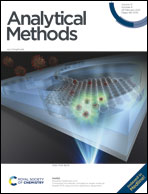Comparison of sample preparation methodologies towards optimisation of Raman spectroscopy for peripheral blood mononuclear cells†
Abstract
The exquisite sensitivity of Raman spectroscopy to the molecular composition of biological samples has been a particular strength in its development towards clinical applicates. Its strength in this regard also presents challenges in the development of its diagnostic capabilities owing to its sensitivity, not only to the sample biochemistry, but also the preparation methodology employed prior to analysis. Here we have examined and optimised several approaches to the preparation of peripheral blood mononuclear cells (PBMCs), or immune cell subtypes of whole blood, for Raman spectroscopic analysis. Two approaches to the elimination of haemoglobin contamination, and two approaches to the purification of the lymphocyte portion of whole blood were investigated. It was found that a peroxide treatment of PBMCs prior to spectroscopic analysis was required for elimination of haemoglobin, while a negative selection approach involving magnetically labelled monoclonal antibodies was preferred for purification of individual leucocyte subpopulations in comparison to the plastic adherence method using an ex vivo culture. Further spectral fitting analysis has identified spectral features of interest which may be useful in the identification of individual leucocytes spectrally and warrant further investigation.



 Please wait while we load your content...
Please wait while we load your content...